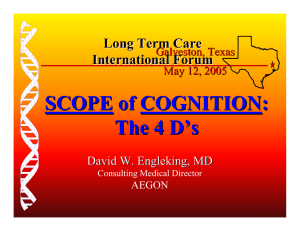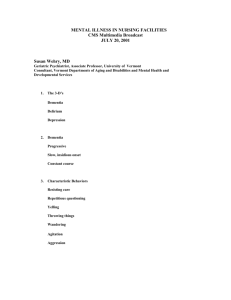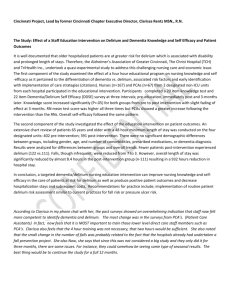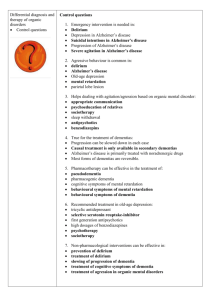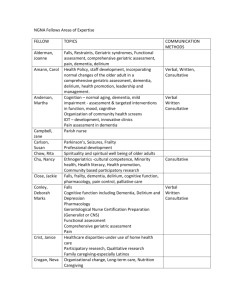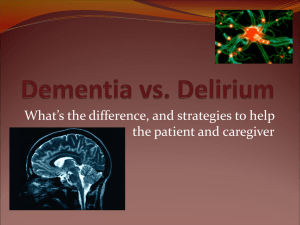Who Am I? Where Am I? Facts and Fears About
advertisement
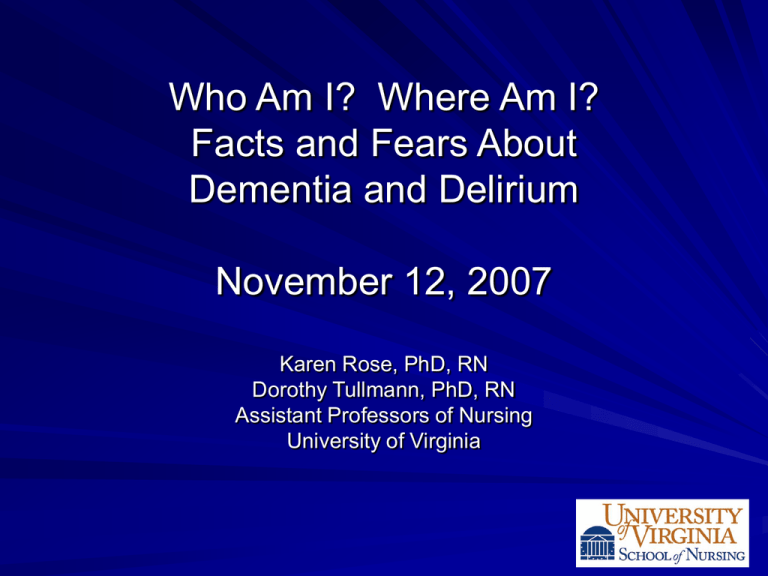
Who Am I? Where Am I? Facts and Fears About Dementia and Delirium November 12, 2007 Karen Rose, PhD, RN Dorothy Tullmann, PhD, RN Assistant Professors of Nursing University of Virginia Presentation Objectives Dementia – Focus on long-term aspects of caring for persons with dementia – Emphasize caregiving environment Delirium – How delirium differs from dementia – Importance of early recognition of delirium What is Dementia Dementia is a general term for the loss of memory and other intellectual abilities serious enough to interfere with daily life. Classifications – Alzheimer’s disease (AD): 50% - 70% of all dementias – Vascular dementia – Mixed dementia – Frontotemporal lobe dementia – Lewy Body dementia – Mild cognitive impairment – Others How Common is Dementia? < 65 years Rare – Less than 4% of all cases of dementia 65 – 85 years 10% – At age 65, risk increases 1% per year 86 – 100+ years 50% – At age 86, risk increases 11% per year The fear of developing dementia is FAR greater!! Alzheimer’s Quiz! Fact or Fiction? 1. Memory loss is a natural part of the aging process. 2. Alzheimer’s is a fatal disease. 3. All relatives of Alzheimer’s patients inherit the disease. 4. Alzheimer’s is a disease of the elderly. 5. Life is over upon receiving an Alzheimer’s diagnosis. Who Are Caregivers? Family caregivers are the mainstay of caregiving support to persons with dementia. Over 30 percent of caregivers for the elderly are, themselves, age 65 years or older. U.S. Department of Health and Human Services, 2001 Living with Alzheimer’s Audio from Vermont Public Radio, November 6, 2007 Benefits of Caregiving Psychological – Self-worth – Altruism – Connection with care recipient Economic – Costs of care at home vs. costs of care in institutions Home care: ≈ $19,000 / year In California alone, cost of care is 2.1 billion now; 4.6 billion in 2020. Alzheimer’s Association, 2006; Fox et al., 2001 Perils of Caregiving Physical – Increased risks for: Cardiovascular disease Metabolic syndrome Other co-morbidities Mortality Psychological – Increased incidence of: Anxiety Depressive symptoms Connell et al., 2001; Gallicchio, 2002; Irwin, 2001; Schulz & Beech, 1999 Caring for the Caregiver Importance of caring for self – For you – For them Community resources – One size does not fit all Importance of Caregiving Environment Socialization (Zarit et al., 2004). Activities (Rentz et al., 2002; Palo-Bengtsson & Ekman, 2002). Mental & Physical Stimulation (Camp et al., 1997). Sleep (Richards, Beck, et al., 2001). When Things Go Bad Dementia is a PROGRESSIVE loss of memory and function…. – When changes are abrupt: Something’s wrong!! What is Delirium? “Semantic muddle” – Acute brain syndrome – Acute confusion – Acute confusional states – Acute brain failure – ICU (intensive care unit) psychosis – Sundowner syndrome Lipowski, 1990 Definition of Delirium Reduced level of consciousness – difficulty focusing, shifting or sustaining attention Cognitive change – deficit of language, memory, orientation, perception; not attributed to dementia Develops rapidly (hours to days) – varies during the day General medical condition has directly caused the condition American Psychological Association, 2002 Variations of Delirium Hyperactive – Increased responsivity to stimuli; hyperalert – Moves constantly; may be combative Hypoactive – Quiet and listless; hypoalert – Appears indifferent, oblivious Mixed – Alternates irregularly American Psychological Association, 2000 How Does Delirium Differ from Dementia? Delirium Rapid onset Fluctuates; worse at night Altered level of consciousness Easily distracted; attention impaired Dementia Chronic, insidious Symptoms progressive but stable Level of consciousness usually not affected Tries hard to do task; great effort to recall What Causes Delirium? The pathogenesis of delirium is unclear. – Anatomic defects? Changes in different parts of the brain seen on diagnostic scans – Neurotransmitter imbalance? Serotonin, acetylcholine deficit Dopamine excess See Trzepacz, 2000 in “Further Reading” – Genetic predisposition? Who is At Risk for Delirium? Predisposing factors – Age (60+ years) – Brain damage – Chronic brain disease (e.g. Alzheimer’s) Precipitating factors (organic causes) – – – – Primary cerebral disease Systemic diseases affective brain (e.g. sepsis) Drug, poison intoxication (e.g. polypharmacy) Withdrawal from substances of abuse (especially alcohol and sedative-hypnotics) Lipowski, 1990; Inouye et al, 1999 Facilitating factors – Psychosocial stress – Sleep deprivation – Sensory underload or overload – Immobilization Lipowski, 1990; Inouye et al., 1999 Delirium in ICU New instrument to screen for delirium in ICU (non-verbal patients) – Higher mortality rate – Long-term cognitive and functional decline Mechanically ventilated patients – > 80% had at least one day of delirium – Related to intravenous sedation In ICU patients, 65+ years – 31% had delirium on admission to the ICU – 31% developed delirium in ICU Ely et al., 2001, 2004; McNicoll et al., 2003 What Can Be Done in the Hospital? Early recognition Treat underlying condition – Medication reaction – Infection Non-pharmacologic management Medication (antipsychotics, sedatives) should be a last resort. What Can I Do? If you see rapid mental changes, report them. – The changes could signal an undetected illness or other physiologic problem. Delirium may be prevented or slowed. – Minimize psychosocial stress – Avoid sleep deprivation – Avoid sensory underload or overload – Avoid immobilization – Frequent reorientation Thank you! Questions?
